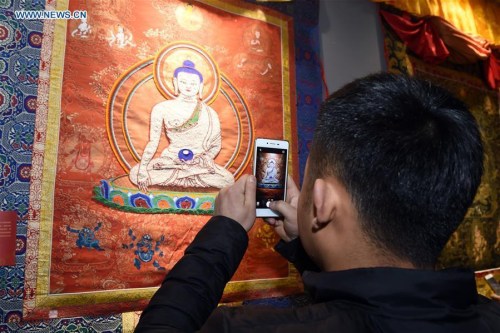
A visitor takes photos of a piece of Thangka work at an exhibition of Tibetan Thangka painting in Lanzhou, capital of northwest China's Gansu Province, Jan. 18, 2016. Thangka, a Tibetan scroll-banner depicting various kinds of contents, has become a valuable kind of collection in recent years. (Photo: Xinhua/Fan Peishen)
When Sanggyaipo was taught to write the Tibetan alphabet in school in northwest China's Qinghai Province, he mischievously drew a mini Buddha with every stroke.
So began a passion for ethnic art that has seen Sanggyaipo, now 51, become a star of thangka, Tibetan Buddhist scroll paintings that have become fashionable -- and highly profitable -- in recent years.
A giant thangka that Sanggyaipo has recently completed after five exhausting years of research and painting is due to go on display in Beijing later this year. Here is the story of how he became a leading Chinese artist, pulling himself up from poverty and helping repair threatened Tibetan antiques along the way.
After school, young Sanggyaipo spent most of his time watching thangka masters in his village, the Tibetan autonomous prefecture of Huangnan, a cradle of thangka painting.
Sanggyaipo was eager to have a go himself. Life was hard and his family could not afford to buy him decent paper, but he enjoyed painting all the same, on used woven bags which he had cut into pieces.
After he finished middle school at 16, he began an apprenticeship with Gyaimoco, one of the great thangka painters. Sanggyaipo spent more than 10 years in his master's house, learning painting techniques and helping with the household chores in his spare time.
PAINTING BUDDHA'S SCROLLS
Sanggyaipo was starting to win acclaim for his art in the early 1990s, when a pilgrimage to the major Taer Monastery led to a lucky break that was to change his life.
The senior Buddhist who blessed Sanggyaipo asked his profession. "He was apparently impressed when I told him I was a thangka painter. He asked me to write down my permanent address," Sanggyaipo remembered.
A few days later, the senior Buddhist visited his family with a job offer: to help with a state-financed project to repair murals at Taer Monastery.
Sanggyaipo and eight other thangka painters spent three years restoring the original look of 36 murals at the monastery.
He earned about 30,000 yuan for the job, a considerable amount for his impoverished family. "Taer Monastery was the birthplace of Tsongkhapa, the founder of the Yellow Hat Sect of Tibetan Buddhism. As I painted Buddha's scrolls, I earned my first fortune right there under His watchful eyes," said Sanggyaipo.
He spent another two decades repairing more murals and thangka at monasteries in Qinghai and Gansu provinces and even at the Potala Palace in Lhasa, experiences he views as a "special honor."


















































